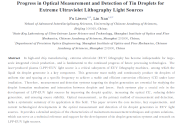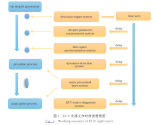You are using an out of date browser. It may not display this or other websites correctly.
You should upgrade or use an alternative browser.
You should upgrade or use an alternative browser.
Chinese semiconductor thread II
- Thread starter vincent
- Start date
broadsword
Brigadier
Any domestic suppliers for PFC controller?
Very common control for power electronics. It improves the efficiency of power output.
Alibaba will open doors for you.
GrainBoundary Technology Completes USD 10 Million B3 Round of Financing to Accelerate the Development of AI Native 3D Graphics Engine
Recently, Grain World Technology, a domestic 3D graphics engine company, completed a B3 round of financing worth tens of millions of dollars. This round of financing was jointly led by Wuxi Wuxi Venture Capital, Wuxi Binhu Industrial Group and BYD, and followed by old shareholder Everest Venture Capital and other institutions.
In addition to being used to upgrade the native AI of GritGene, the 3D graphics engine of GritGene, this round of financing will also be used for research and development in simulation training of embodied intelligence and world models, multimodal intelligent human-computer interaction, and further implementation and commercialization in more industry vertical scenarios such as smart cockpits, terminal graphics, and spatial intelligence.
GritWorld Technology was founded in 2015. Its founder and CEO, Dr. Wu Xiaomao, graduated from the Department of Computer Science at Shanghai Jiao Tong University. The company is a provider of next-generation computer graphics engine technology, and its core product is the next-generation computer graphics rendering engine GritGene. GritWorld Technology has cooperated with Huawei, BYD, Honor and other companies to apply 3D graphics engine technology to consumer terminals such as mobile phones, mixed reality devices, and automobiles, as well as digital twins, film and television special effects, and spatial intelligence, to promote the research and development and commercialization of the third-generation 3D graphics engine with intelligent heterogeneity.
The clean room of the second phase of the expansion of ZX Electronics Zhejiang Yiwu Wafer Factory (Yfab) was put into use and new equipment was moved in
China's leading silicon carbide (SiC) power device and chip solution provider Zhanxin Electronics held a grand event themed "Eight Years of Innovation, Unlimited Passion for 8" at Zhejiang Yiwu Wafer Factory (Yfab).
On July 17, China's leading provider of silicon carbide (SiC) power devices and chip solutions, Zhanxin Electronics, held a grand celebration of its 8th anniversary with the theme of "Eight Years of Innovation, Unlimited Passion" at Zhejiang Yiwu Wafer Factory (Yfab). Leaders of Yiwu Economic Development Zone, shareholder representatives, key equipment suppliers and all Zhanxin people gathered together to witness the important moment of the opening of the second phase of the expansion clean room of Zhejiang Yiwu Wafer Factory (Yfab) and the move-in of new equipment.

Zhongke Semiconductor releases GaN robot intelligent fast charging chip
Zhongke Semiconductor released four models of gallium nitride (GaN) ASIC smart fast-charging chips (including: CT-3602, CT1020, CT1007 and CT-1901). Through the differentiated design of "gallium nitride ASIC chip + GaN power tube" integration, it is a fast-charging dedicated chip customized for robots.
The chip includes four specifications: 1000W, 200W, 100W, and 65W. The chip has a built-in fast charging protocol. In response to the 1000W supercharging scenario, it monitors the battery status in real time and forms a full-cycle charging closed-loop monitoring and management of the electron migration process through artificial intelligence algorithm technology and high-sampling rate ADC monitoring.
It safely monitors the voltage, current, battery thermal runaway, overcharge protection, current mutation and inferior batteries during the battery charging process, reduces the risk of electron migration caused by abnormal current and the charging disconnection response under extreme working conditions, and reduces the charging safety of "high-rate and large-capacity batteries" in a home environment. It is a dedicated intelligent supercharging ASIC chip solution designed for high-power and high-rate battery charging application scenarios such as home robots, industrial robots, and medical robots.
other products

The chip includes four specifications: 1000W, 200W, 100W, and 65W. The chip has a built-in fast charging protocol. In response to the 1000W supercharging scenario, it monitors the battery status in real time and forms a full-cycle charging closed-loop monitoring and management of the electron migration process through artificial intelligence algorithm technology and high-sampling rate ADC monitoring.
It safely monitors the voltage, current, battery thermal runaway, overcharge protection, current mutation and inferior batteries during the battery charging process, reduces the risk of electron migration caused by abnormal current and the charging disconnection response under extreme working conditions, and reduces the charging safety of "high-rate and large-capacity batteries" in a home environment. It is a dedicated intelligent supercharging ASIC chip solution designed for high-power and high-rate battery charging application scenarios such as home robots, industrial robots, and medical robots.
other products

Nope. Most of them are distributors of foreign partsAlibaba will open doors for you.
New progress in high repetition rate fully coherent free electron laser research
Recently, the free electron laser team of the Shanghai Advanced Research Institute of the Chinese Academy of Sciences has made progress in the research of new mechanisms of high repetition rate fully coherent free electron laser (FEL). For the first time, the independently proposed new mechanism of "direct amplification driven harmonic generation" (DEHG-FEL) has been experimentally verified, and its light amplification and stable operation have been successfully achieved. This marks a key step on the road to achieving fully coherent extreme ultraviolet (EUV) and X-ray FEL light sources with a repetition rate of megahertz (MHz).
High repetition rate fully coherent EUV and soft X-ray FELs have important application prospects in cutting-edge fields such as advanced time-resolved spectroscopy, coherent diffraction imaging, and ultrafast dynamics research of nanostructures and nanodevices. However, traditional exogenous seeded FEL schemes usually require ultraviolet seed lasers with peak powers of up to hundreds of megawatts to drive them, which limits their repetition rates to the kilohertz level.
The free electron laser team of Shanghai Advanced Research Institute has previously verified the self-amplification mechanism of coherent energy modulation at the Shanghai Soft X-ray Free Electron Laser Facility (SXFEL). In this work, the research team used a long modulation segment to directly amplify the weak seed laser signal through a high-gain FEL process, thereby obtaining a high-power, stable modulated laser. In this process, the electron beam obtained sufficient energy modulation, and formed a coherent micro-bunch on the scale of the optical wavelength through the dispersion segment, thereby generating a fully coherent radiation output up to the 12th harmonic. The team further amplified the 7th harmonic to saturation, and obtained a saturated pulse energy of about 160 microjoules, with an energy stability of 5.5%. Through the harmonic cascade process, the team also successfully achieved 16th harmonic output, and the output spectral bandwidth was close to the Fourier transform limit, which shows that the DEHG-FEL has been well maintained in terms of longitudinal coherence.
DEHG technology can effectively amplify extremely weak seed laser signals with its simple device configuration. In principle, it can reduce the seed laser power by two to three orders of magnitude and has the ability to output high-order harmonics in a stable, controllable manner, which is particularly suitable for high-repetition-rate exo-seed free electron lasers. In addition, it has the potential to provide a solution for achieving high repetition rates for more complex two-stage seed schemes (such as echo-driven harmonic generation, EEHG). In the future, this scheme is expected to be combined with high-order harmonic generation technology (HHG) to provide a new means for ultrafast spectroscopy, imaging and materials science research in the soft X-ray band.
The relevant research results were published in Physical Review Letters under the title " First Lasing and Stable Operation of a Direct-Amplification Enabled Harmonic Generation Free-Electron Laser" and were selected as an "Editor's Recommendation" article .
This research was supported by the Shanghai Soft X-ray Free Electron Laser Facility, the National Key R&D Program, the National Natural Science Foundation, the Chinese Academy of Sciences' Stable Support Program for Young Teams in Basic Research, and Shanghai's Major Science and Technology Projects.
High repetition rate fully coherent EUV and soft X-ray FELs have important application prospects in cutting-edge fields such as advanced time-resolved spectroscopy, coherent diffraction imaging, and ultrafast dynamics research of nanostructures and nanodevices. However, traditional exogenous seeded FEL schemes usually require ultraviolet seed lasers with peak powers of up to hundreds of megawatts to drive them, which limits their repetition rates to the kilohertz level.
The free electron laser team of Shanghai Advanced Research Institute has previously verified the self-amplification mechanism of coherent energy modulation at the Shanghai Soft X-ray Free Electron Laser Facility (SXFEL). In this work, the research team used a long modulation segment to directly amplify the weak seed laser signal through a high-gain FEL process, thereby obtaining a high-power, stable modulated laser. In this process, the electron beam obtained sufficient energy modulation, and formed a coherent micro-bunch on the scale of the optical wavelength through the dispersion segment, thereby generating a fully coherent radiation output up to the 12th harmonic. The team further amplified the 7th harmonic to saturation, and obtained a saturated pulse energy of about 160 microjoules, with an energy stability of 5.5%. Through the harmonic cascade process, the team also successfully achieved 16th harmonic output, and the output spectral bandwidth was close to the Fourier transform limit, which shows that the DEHG-FEL has been well maintained in terms of longitudinal coherence.
DEHG technology can effectively amplify extremely weak seed laser signals with its simple device configuration. In principle, it can reduce the seed laser power by two to three orders of magnitude and has the ability to output high-order harmonics in a stable, controllable manner, which is particularly suitable for high-repetition-rate exo-seed free electron lasers. In addition, it has the potential to provide a solution for achieving high repetition rates for more complex two-stage seed schemes (such as echo-driven harmonic generation, EEHG). In the future, this scheme is expected to be combined with high-order harmonic generation technology (HHG) to provide a new means for ultrafast spectroscopy, imaging and materials science research in the soft X-ray band.
The relevant research results were published in Physical Review Letters under the title " First Lasing and Stable Operation of a Direct-Amplification Enabled Harmonic Generation Free-Electron Laser" and were selected as an "Editor's Recommendation" article .
This research was supported by the Shanghai Soft X-ray Free Electron Laser Facility, the National Key R&D Program, the National Natural Science Foundation, the Chinese Academy of Sciences' Stable Support Program for Young Teams in Basic Research, and Shanghai's Major Science and Technology Projects.
Annual output of 600,000 tons! Chongqing ultra-white quartz sand project put into production
The project is being built by Chongqing Yujin Silicon New Materials Co., Ltd. with an estimated total investment of 350 million yuan, covering an area of more than 40,000 square meters. It will be built in two phases. The first phase of the project covers an area of about 20,000 square meters. The company currently has one ultra-white quartz sand purification production line with a high degree of automation and environmental protection standards. The two core production lines of the project were put into operation last year.

It is reported that ultra-white glass is a low-iron, high-transparency silicate glass made with low-iron quartz sand as the main raw material. The photovoltaic industry is the main application field of ultra-white glass. Low-iron quartz sand is the most important raw material for ultra-white glass production, and it generally accounts for more than 60% of the raw materials for ultra-white glass. The iron content in the raw materials has the greatest impact on the transmittance of ultra-white glass, followed by titanium, because a higher iron content will make ultra-white glass green, while a higher titanium content will make ultra-white glass yellow, both of which will reduce the transmittance of visible light. Therefore, low-iron quartz sand must be used to meet the quality requirements of ultra-white glass.
In short, the characteristics of ultra-white low-iron quartz sand with high silicon content and low iron content can ensure the uniform stability and high light transmittance of glass, and is the preferred material for preparing high-quality photovoltaic ultra-white glass, photovoltaic new energy components, etc. The demand for low-iron quartz sand is huge, and it is a type of quartz raw material product that plays an important role in the high-quality development of my country's photovoltaic industry.


